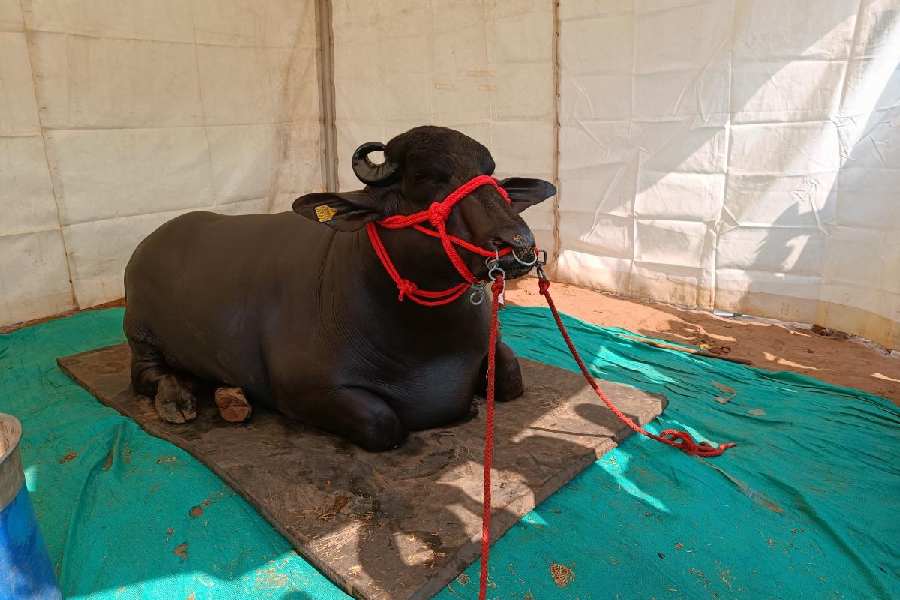Gholu II, a massive 1,600kg buffalo from Haryana, emerged as the star attraction at the three-day Bihar Dairy and Cattle Expo–2023, which concluded on Saturday.
Hailing from the indigenous Murrah breed, six-year-old Gholu-II’s royal looks and shiny black skin swept the visitors off their feet.
People thronged to see Gholu-II tower high over others at five-and-a-half feet at its hips — the place where cattle height is measured. Whenever he craned his neck, its head touched seven feet or more. He is 15 feet long and four-and-a-quarter feet wide.
Farmers who have cows and buffaloes at home gasped whenever he blinked and sighed or flapped his ears.
“Rarest of the rare” is how Gholu-II’s owner and Padma Shri award winner (in 2019) Narendra Singh Poonia, a resident of Didwari village in Haryana’s Panipat district, describes the buffalo.
“Some big dairy firms and semen banks from Andhra Pradesh and Uttar Pradesh have offered Rs 10 crore to buy him. But I will never sell him. For me, even Rs 50 crore will be less for him. He is like my baby. Isne mera aur mere desh ka naam roshan kiya hai (He has brought much fame to me and the country). He is the pride of Haryana and India,” Narendra told The Telegraph.
Scientists, researchers and dairy farmers from Australia, the US, Brazil, Holland, Ukraine and several other countries have come to see Gholu-II. They have also offered to buy him, but Narendra would not part with him.
The buffalo has been named after its grandfather Gholu-I, who was also massive. His father was not very good, but Gholu-II turned out to be exceptional.
“It grew and grew and kept growing till it surpassed all others by the time it reached the age of two. Of course, with this size, it eats more than any ordinary buffalo. We spend around Rs 1,500 per day on providing wheat, gram, maize, jaggery, jowar, oilcakes and other types of fodder,” said Raj Kumar, a relative of Narendra, who monitors the daily care of the animal.
Gholu-II has a separate, full-time attendant, who gives him a daily massage of mustard oil and feeds him. Back home, he stays in an air-conditioned room though he was put up in a tent at the cattle fair in Patna.
However, Gholu-II more than makes up for all the money spent on him. Doctors, dairy farmers, cattle semen traders and institutions, and common people from all over the country come to buy his semen for the artificial insemination of their buffaloes. Its female offspring are also sold at around Rs 1.5 lakh each as they provide up to 20 litres of milk every day.
“We earn Rs 8 lakh to 10 lakh a month, mostly by selling semen of Gholu-II. One dose is sold for Rs 500, though we are offering it for just Rs 300 each at this cattle expo. It is the father of at least 30,000 babies in India and abroad. Though, every semen dose does not result in baby buffaloes,” Raj Kumar added.
Gholu-II was brought on a truck to the expo and six people had accompanied Narendra to take care of everything at the fair.
As thousands of people flock to catch a glimpse of the buffalo, Gholu-II keeps sitting or standing quietly.
“Gholu-II enjoys being the centre of attraction. He likes being around people. The more the merrier. We have a TV in his room back in the village, where he watches news and songs keenly. He shakes his head rhythmically if he likes the music,” Narendra said.
Narendra asserted that Gholu-II has made a difference in improving the breed of buffaloes in Haryana.
“I want to contribute my bit to improving the breed of cattle in the country. We have good ones in Haryana and a few other states. However, Bihar is lagging in this. We must avoid inbreeding of cattle and go for improving the breed, be it cows or buffaloes,” Narendra said.
“The times are such that no farmer can do well without animal husbandry. Also, India should focus more on the improvement and expansion of indigenous breeds instead of being charmed by foreign breeds as they are more suitable for our climatic conditions,” Narendra added.
Domesticated buffaloes can live up to 40 years and Gholu-II is young. He has a son called Vidayak, which is growing fast and is expected to catch up with it in shape, size and weight.

